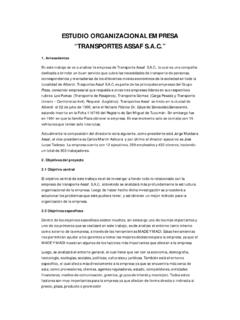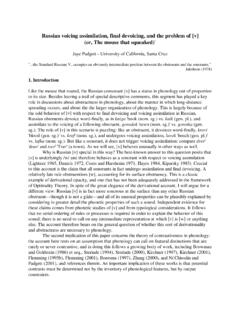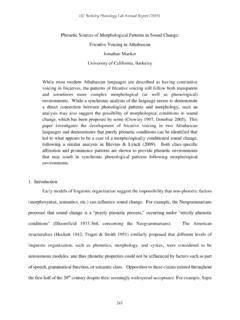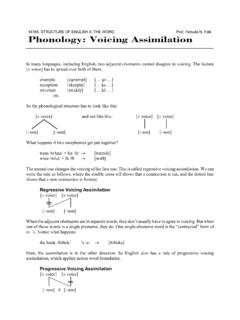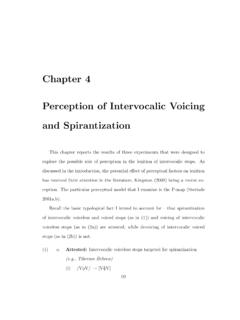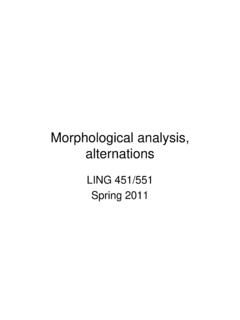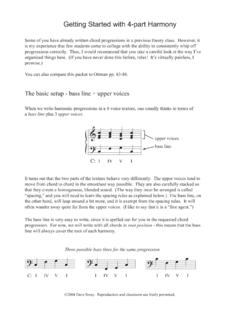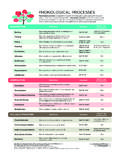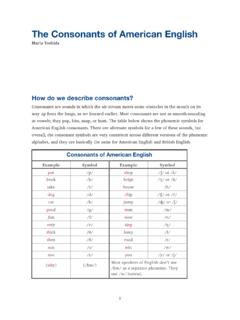Transcription of 4 Voicing and consonants
1 4 voicing and consonants The larynx We begin this chapter by studying the larynx. The larynx has several very important functions in speech, but before we can look at these functions we must examine its anatomy and physiology - that is, how it is constructed and how it works. The larynx is in the neck; it has several parts, shown in Fig. 10. Its main structure is made of cartilage, a material that is similar to bone but less hard. If you press down on your nose, the hard part that you can feel is cartilage. The larynx's structure is made of two large cartilages. These are hollow and are attached to the top of the trachea; when we breathe, the air passes through the trachea and the larynx. The front of the larynx comes to a point and you can feel this point at the front of your neck - particularly if you are a man and/or slim. This point is commonly called the Adam's Apple.
2 Inside the "box" made by these two cartilages are the vocal folds, which are two thick flaps of muscle rather like a pair of lips; an older name for these is vocal cords. Looking down the throat is difficult to do, and requires special optical equipment, but Fig. 11 shows in diagram form the most important parts. At the front the vocal folds are joined together and fixed to the inside of the thyroid cartilage. At the back they are attached to a pair of Fig. 10 The larynx small cartilages called the arytenoid cartilages so that if the arytenoid cartilages move, the vocal folds move too. The arytenoid cartilages are attached to the top of the cricoid cartilage, but they can move so as to move the vocal folds apart or together (Fig. 12). We use the word glottis to refer to the opening between the vocal folds. If the vocal folds are apart we say that the glottis is open; if they are pressed together we say that the glottis is closed.
3 This seems quite simple, but in fact we can produce a very complex range of changes in the vocal folds and their positions. These changes are often important in speech. Let us first look at four easily recognisable states of the vocal folds; it would be useful to practise moving your vocal folds into these different positions. Wide apart: The vocal folds are wide apart for normal breathing and usually during voiceless consonants like p, f, s (Fig. 13a). Your vocal folds are probably apart now. Narrow glottis: If air is passed through the glottis when it is narrowed as in Fig. 13b, the result is a fricative sound for which the symbol is h. The sound is not very different from a whispered vowel. It is called a voiceless glottal fricative. (Fricatives are discussed in more detail in Chapter 6.) Practise saying hahahaha - alternating between this state of the vocal folds and that described in (iii) below.
4 Position for vocal fold vibration: When the edges of the vocal folds are touching each other, or nearly touching, air passing through the glottis will usually cause vibration (Fig. 13c). Air is pressed up from the lungs and this air pushes the vocal folds apart so that a little air escapes. As the air flows quickly past the edges of the vocal folds, the folds are brought together again. This opening and closing happens very rapidly and is repeated regularly, roughly between two and three hundred times per second in a woman's voice and about half that rate in an adult man's voice. iv) Vocal folds tightly closed: The vocal folds can be firmly pressed together so that air cannot pass between them (Fig. 13d). When this happens in speech we call it a glottal stop or glottal plosive, for which we use the symbol ?. You can practise this by coughing gently; then practise the sequence a?a?a?a?
5 A?a. Respiration and Voicing Section referred several times to air passing between the vocal folds. The normal way for this airflow to be produced is for some of the air in the lungs to be pushed out; when air is made to move out of the lungs we say that there is an egressive pulmonic airstream. All speech sounds are made with some movement of air, and the egressive pulmonic is by far the most commonly found air movement in the languages of the world. There are other ways of making air move in the vocal tract, but they are not usually relevant in the study of English pronunciation, so we will not discuss them here. How is air moved into and out of the lungs? Knowing about this is important, since it will make it easier to understand many aspects of speech, particularly the nature of stress and intonation. The lungs are like sponges that can fill with air, and they are contained within the rib cage (Fig.)
6 14). If the rib cage is lifted upwards and outwards there is more space in the chest for the lungs and they expand, with the result that they take in more air. If we allow the rib cage to return to its rest position quite slowly, some of the air is expelled and can be used for producing speech sounds. If we wish to make the egressive pulmonic airstream continue without breathing in again - for example, when saying a long sentence and not wanting to be interrupted - we can make the rib cage press down on the lungs so that more air is expelled. In talking about making air flow into and out of the lungs, the process has been described as though the air were free to pass with no obstruction. But, as we saw in Chapter 2, to make speech sounds we must obstruct the airflow in some way - breathing by itself makes very little sound. We obstruct the airflow by making one or more obstructions or strictures in the vocal tract, and one place where we can make a stricture is in the larynx, by bringing the vocal folds close to each other as described in the previous section.
7 Remember that there will be no vocal fold vibration unless the vocal folds are in the correct position and the air below the vocal folds is under enough pressure to be forced through the glottis. If the vocal folds vibrate we will hear the sound that we call Voicing or phonation. There are many different sorts of Voicing that we can produce - think of the differences in the quality of your voice between singing, shouting and speaking quietly, or think of the different voices you might use reading a story to young children in which you have to read out what is said by characters such as giants, fairies, mice or ducks; many of the differences are made with the larynx. We can make changes in the vocal folds themselves - they can, for example, be made longer or shorter, more tense or more relaxed or be more or less strongly pressed together.
8 The pressure of the air below the vocal folds (the subglottal pressure) can also be varied. Three main differences are found: Variations in intensity: We produce Voicing with high intensity for shouting, for example, and with low intensity for speaking quietly. Variations in frequency: If the vocal folds vibrate rapidly, the Voicing is at high frequency; if there are fewer vibrations per second, the frequency is lower. Variations in quality: We can produce different-sounding voice qualities, such as those we might call harsh, breathy, murmured or creaky. Plosives A plosive is a consonant articulation with the following characteristics: One articulator is moved against another, or two articulators are moved against each other, so as to form a stricture that allows no air to escape from the vocal tract. The stricture is, then, total. After this stricture has been formed and air has been compressed behind it, it is released - that is, air is allowed to escape.
9 If the air behind the stricture is still under pressure when the plosive is released, it is probable that the escape of air will produce noise loud enough to be heard. This noise is called plosion. d) There may be Voicing during part or all of the plosive articulation. To give a complete description of a plosive consonant we must describe what happens at each of the following four phases in its production: The first phase is when the articulator or articulators move to form the stricture for the plosive. We call this the closing phase. The second phase is when the compressed air is stopped from escaping. We call this the compression phase. The third phase is when the articulators used to form the stricture are moved so as to allow air to escape. This is the release phase. The fourth phase is what happens immediately after (iii), so we will call it the post-release phase.
10 English plosives English has six plosive consonants : p, t, k, b, d, g. The glottal plosive ? occurs frequently but it is of less importance, since it is usually just an alternative pronunciation of p, t, k in certain contexts. The plosives have different places of articulation. The plosives p, b are bilabial since the lips are pressed together (Fig. 15); t, d are alveolar since the tongue blade is pressed against the alveolar ridge (Fig. 16). Normally the tongue does not touch the front teeth as it does in the dental plosives found in many languages. The plosives k, g are velar; the back of the tongue is pressed against the area where the hard palate ends and the soft palate begins (Fig. 17). The plosives p, t, k are always voiceless; b, d, g are sometimes fully voiced, sometimes partly voiced and sometimes voiceless. We will consider what b, d, g should be called in Section below.



